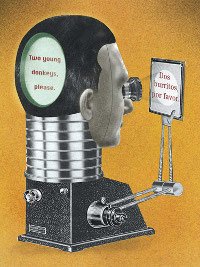Desktop publishing urgent question Thread poster: Gregory Lassale
|
|---|
I received a small PDF brochure to translate that involves desktop publishing. The documents includes regular text but also a logo + tag line image as well as scanned images of text edited in either Word, Excel or some DTP program. The client made it clear they expect a carbon copy of the original and I am a bit at a loss. How do you figure out what font was used for the scannned text? The color used? And how do you recreate the same layout?
I have 3 days to figure this out...
... See more I received a small PDF brochure to translate that involves desktop publishing. The documents includes regular text but also a logo + tag line image as well as scanned images of text edited in either Word, Excel or some DTP program. The client made it clear they expect a carbon copy of the original and I am a bit at a loss. How do you figure out what font was used for the scannned text? The color used? And how do you recreate the same layout?
I have 3 days to figure this out...
Your help much appreciated.
Thanks! ▲ Collapse
| | | | neilmac
Spain
Local time: 04:24
Spanish to English
+ ...
This kind of job is a nightmare and I avoid them by clearly stating in my terms and conditions that I only work with Word-compatible texts, at basic rates. Everything else is charged according to the complexity and time taken, and the estimate I give is usually so expensive that the clients can somehow miraculously provide the texts in workable format, even if it means retyping the content themselves and formatting it again a posteriori.
| | | |
Hello Gregory,
If you check the properties of the PDF, does it tell you which application generated it? This will also tell you which Fonts are used. If they are proprietary/commercial fonts (that you need to byu), i think there is no way you can replicate them 100% with free font substitutes.
If it's Word, you can try a PDF to Word converter. OCR is also an option... If there are images with embedded text, you'd have to extract them and localize them separately, befor... See more Hello Gregory,
If you check the properties of the PDF, does it tell you which application generated it? This will also tell you which Fonts are used. If they are proprietary/commercial fonts (that you need to byu), i think there is no way you can replicate them 100% with free font substitutes.
If it's Word, you can try a PDF to Word converter. OCR is also an option... If there are images with embedded text, you'd have to extract them and localize them separately, before replacing them in Word.
If it's Indesign and/or if the layout is getting complex, ask for the IDML (or INDD) file or for the original file, making it clear otherwise the layout won't be a carbon copy, only an approximation. You'd have to own InDesign to work on the final layout, or have the client make the required fixes. I don't think it's feasible to replicate such layouts in Word, that's why there are dedicated DTP programs for that. I'd suggest you abort if the expectations are not reasonable.
TransPDF.com is supposed to let you extract the text in a xliff file that you can then translate in a CAT tool, finetune the translated layout in Infix PDF Editor for free, and then pay a small fee to get a PDF conversion. If the client requested a PDF back, this may work, but I don't suggest you try that in a hurry. Infix is Windows software, but works with Wine, so it should via PlayOnMac (free) or CrossOver Mac (paid).
You can also try a PDF Editor (Adobe Acrobat) for editing directly, but it will be a real pain if its more than just a few pages.
You can find more details, and specific (online/offline) software suggestions at the PDF section of my "File formats" reference file for CafeTran. The PDF section is pretty CAT tool agnostic:
https://github.com/idimitriadis0/TheCafeTranFiles/wiki/4-File-formats#pdf
PS: I agree with Neilmac: quote a 50-100% rate increase for the job, and the client will somehow discover the lost original file.
[Edited at 2018-10-04 06:05 GMT] ▲ Collapse
| | | | Rolf Keller
Germany
Local time: 04:24
English to German
| What means "original"? | Oct 4, 2018 |
Gregory Lassale wrote:
The client made it clear they expect a carbon copy of the original
The client gave you a .pdf only? This is your original, then. So you don't have to know which application (Word, InDesign, Quark, …) was used (hi, @Jean). Just create a document in an arbitrary application, use any dirty or sophisticated formatting functions (e. g. created by an OCR software) as you want, export the result as .pdf and deliver the .pdf only.
But from the client's point of view this would be a stupid solution: As .pdf files offer limited editing features, the client will - next week or next year - run into problems if some changes are to be made for a future or amended version.
Of course you can turn down such "dirty" work by offering a very high price. It depends on several things whether or not this is a reasonable solution.
| | |
|
|
|
You can download the Infix demo from https://www.iceni.com/infix_download.htm
Open your file with it, click on Document | Fonts, and you'll get the list of fonts used. The sequence of apparently random letters added to the font name there is an indication that the font usage was "tweaked" as used in the document, i.e. non-default tracking, kerning, spacing, width, etc.
B... See more You can download the Infix demo from https://www.iceni.com/infix_download.htm
Open your file with it, click on Document | Fonts, and you'll get the list of fonts used. The sequence of apparently random letters added to the font name there is an indication that the font usage was "tweaked" as used in the document, i.e. non-default tracking, kerning, spacing, width, etc.
BTW Infix was devised exactly to help you do the job you apparently have now. ▲ Collapse
| | | | Gregory Lassale 
United States
Local time: 21:24
English to French
TOPIC STARTER
Hello all,
I lied. The file I received is actually a .docx Word document (though client wants the translation delivered in Word and PDF files - easy enough), but it does contain a couple of embedded images with text that needs to be translated, and I still have no idea how to figure out the font and color used.
@Jean - you mentioned localizing them and placing them back but how do you technically replace the text once you know what font was used? Do you place a text fi... See more Hello all,
I lied. The file I received is actually a .docx Word document (though client wants the translation delivered in Word and PDF files - easy enough), but it does contain a couple of embedded images with text that needs to be translated, and I still have no idea how to figure out the font and color used.
@Jean - you mentioned localizing them and placing them back but how do you technically replace the text once you know what font was used? Do you place a text field over the original one, translate and save the image? I can find ways to do this (but again I need to figure out what font/color to use first) but want to make sure there isn't a better method.
The client made it very explicit that all graphical components must replicated to the smallest detail, and I don't know a way to do that with embedded image files. One looks like Times New Roman, another Arial but there's a third (handwritten type) that I don't recognize.
Thanks for the help. ▲ Collapse
| | | |
Gregory Lassale wrote:
but it does contain a couple of embedded images with text that needs to be translated
Hello, Gregory,
If there is background behind text, I think you can do nothing. Otherwise, open images with Photoshop and just pickup correct font by typing few letters in a new layer and trying to fully fit them to source text. When font is found, type translation over source text (use color pickup tool to find a color) and then erase old text in background layer.
Did it many times. Not kind of job we like to do, but increased hourly rate makes it a bit more attractive.
| | | |
I have successfully used Inkscape (free-libre/open source software, mostly intended for vector images, similar to Adobe Illustrator) in the past for localizing images embedded in Word documents, although there must certainly be other methods, more quick and systematic.
So this is just to give you an idea. Export images from Word document. Import image to Inkscape (or use GIMP/Photoshop beforehand, to remove text), save as SVG while working on it, translate as needed and try to repli... See more I have successfully used Inkscape (free-libre/open source software, mostly intended for vector images, similar to Adobe Illustrator) in the past for localizing images embedded in Word documents, although there must certainly be other methods, more quick and systematic.
So this is just to give you an idea. Export images from Word document. Import image to Inkscape (or use GIMP/Photoshop beforehand, to remove text), save as SVG while working on it, translate as needed and try to replicate the fonts, colors and placements. Then export to PNG or JPG.
You then replace the source image with the translated one in word.
It might help that the image dimensions and resolution are respected.
I generally don't touch images though, too much of a hussle, others might have more experience with that.
PS: Some services like What The Font: https://www.myfonts.com/WhatTheFont/ // https://www.myfonts.com/WhatTheFont/mobile/ might help, I can't say if they will for your images. Maybe you can ask.
Jean
In the future, please describe the situation accurately, to make the provided help more efficient and rewarding.
[Edited at 2018-10-04 17:48 GMT] ▲ Collapse
| | |
|
|
|
Dan Lucas 
United Kingdom
Local time: 03:24
Member (2014)
Japanese to English
| There's a website for that | Oct 4, 2018 |
Gregory Lassale wrote:
One looks like Times New Roman, another Arial but there's a third (handwritten type) that I don't recognize.
Google "font recognition online" and you'll find a bunch of sites that may be able to help. I was surprised that they exist, but I tried one a few years back and it worked well, as I recall.
Dan
| | | | Gregory Lassale 
United States
Local time: 21:24
English to French
TOPIC STARTER | Thank you all | Oct 4, 2018 |
First of all thanks all for your suggestions. I ended up making it work with some screen captures, photoshopping and desktop publishing. Boggles the mind that the client expects identical formatting without providing editable source files, but I think the end result is pretty good nonetheless. Desktop publishing already makes the translation process more challenging with source files but without it's a serious timesuck that needs a hefty upcharge. Lesson learned.
| | | | Gregory Lassale 
United States
Local time: 21:24
English to French
TOPIC STARTER | The way I did it | Oct 5, 2018 |
I tried whatfontis.com but the process can be pretty time consuming, plus I was pretty sure that one font was Times New Roman, the other Arial and I emailed the client who luckily was able to give me the third. The way I did it is I took a screenshot of the image (it was a table), photoshopped the source text out of it and added the translation in various text fields. The font had also been stretched horizontally in it, so I had to finagle there too.
Unfortunately, I had agreed to ... See more I tried whatfontis.com but the process can be pretty time consuming, plus I was pretty sure that one font was Times New Roman, the other Arial and I emailed the client who luckily was able to give me the third. The way I did it is I took a screenshot of the image (it was a table), photoshopped the source text out of it and added the translation in various text fields. The font had also been stretched horizontally in it, so I had to finagle there too.
Unfortunately, I had agreed to a lower rate than normal with this agency before they told me that most of their jobs involved this type of time consuming editing. Lesson learned. ▲ Collapse
| | | | Rolf Keller
Germany
Local time: 04:24
English to German
| Screenshots often are "unprecise" renderings | Oct 7, 2018 |
Gregory Lassale wrote:
I took a screenshot of the image
Screenshots are adapted to the physical resolution of the screen. Such an adaption results in a (sometimes visible) loss of sharpness. It's better to extract the original image files out of the Word file. Actually, .docx files are .zip files, so you can rename the .docx to .zip and extract all image files separately.
| | | | To report site rules violations or get help, contact a site moderator: You can also contact site staff by submitting a support request » Desktop publishing urgent question | Protemos translation business management system | Create your account in minutes, and start working! 3-month trial for agencies, and free for freelancers!
The system lets you keep client/vendor database, with contacts and rates, manage projects and assign jobs to vendors, issue invoices, track payments, store and manage project files, generate business reports on turnover profit per client/manager etc.
More info » |
| | Wordfast Pro | Translation Memory Software for Any Platform
Exclusive discount for ProZ.com users!
Save over 13% when purchasing Wordfast Pro through ProZ.com. Wordfast is the world's #1 provider of platform-independent Translation Memory software. Consistently ranked the most user-friendly and highest value
Buy now! » |
|
| | | | X Sign in to your ProZ.com account... | | | | | |













